Serviços Personalizados
Journal
Artigo
Indicadores
-
 Citado por SciELO
Citado por SciELO -
 Acessos
Acessos
Links relacionados
-
 Citado por Google
Citado por Google -
 Similares em
SciELO
Similares em
SciELO -
 Similares em Google
Similares em Google
Compartilhar
DYNA
versão impressa ISSN 0012-7353versão On-line ISSN 2346-2183
Dyna rev.fac.nac.minas v.77 n.161 Medellín jan./mar. 2010
GENERATION OF RECYCLED AGGREGATES AND TECHNICAL REQUIREMENTS FOR SOME APPLICATIONS
GENERACIÓN DE LOS ÁRIDOS RECICLADOS Y REQUISITOS TÉCNICOS PARA ALGUNAS APLICACIONES
ISABEL MARTÍNEZ LAGE
Universidade da Coruña, España, E.T.S, imartinez@udc.es
CRISTINA VÁZQUEZ HERRERO
Universidade da Coruña, España, E.T.S, cvazquezh@udc.es
BELÉN GONZÁLEZ FONTEBOA
Universidade da Coruña, España, E.T.S, bfonteboa@udc.es
FERNANDO MARTÍNEZ ABELLA
Universidade da Coruña, España, E.T.S, fmartinez@udc.es
Received for review June 12th, 2009, accepted December 20th, 2009, final version December 22th, 2009
ABSTRACT: In the present framework of sustainable construction, management of construction and demolition (C&D) waste or debris is stressed and its correct implementation requires a previous estimation of the precise quantities and detailed composition of C&D waste.This allows us to make an estimate of the production of recycled aggregate and to analyze the impact of its use in relation to the use of natural aggregate. Research of existing bibliography, the results obtained from both experimental testing and previous experience at construction works where C&D debris is used, enabled us to develop technical specifications for each application of the recycled aggregates. This includes recommendations for use, quality control specifications, and the maximum percentage of recycled aggregate that ought to substitute natural aggregate in concrete mixes in order to get admissible performances.
KEY WORDS: Construction and Demolition (C&D), C&D Waste (CDW), C&D Debris, Management of C&D Waste, Quantification of C&D Waste, Composition of C&D Waste, Recycled Aggregate.
RESUMEN: En el marco actual de la Construcción Sostenible destaca la gestión de los Residuos de Construcción y Demolición, cuyo correcto desarrollo exige, primeramente, una cuantificación y una composición suficientemente precisas de los residuos, para así poder realizar una estimación sobre la producción de áridos reciclados y analizar la repercusión que tendría su utilización, con respecto al uso de los áridos naturales. Además, a partir de la bibliografía existente, de los resultados obtenidos en los ensayos y de las experiencias conocidas en obras realizadas con árido reciclado, se confeccionan fichas de utilización para cada aplicación de los áridos reciclados, en las que se incluyen las especificaciones y el control de calidad recomendados, así como el porcentaje de sustitución de árido reciclado por árido natural admisible.
PALABRAS CLAVE: residuos de construcción y demolición (C&D debris), gestión de C&D debris, cuantificación de C&D debris, composición de C&D debris, áridos reciclados.
1. INTRODUCCIÓN
The construction and demolition debris (C&D debris) is the waste that results from construction, rehabilitation and demolition of buildings, public works and works of urbanization. According to the European Waste Catalogue [1], C&D debris includes the excavation of land from previous activities; this material is excluded in most (of the present) management plans and applications at present.
C&D debris is composed of inert waste materials and therefore is not generally dangerous but its volume is so large, that in order to protect the environment, management planning is required. Among its components there are metals, plastics, wood, glass, paper and cardboard which are easily detachable and reusable materials. However, other components such as stone, ceramic, concrete and mortar are very difficult to separate, even if selection is carried out on the site, as they adhere to each other. These materials are used to produce recycled aggregate, and to calculate the amount that can be generated, it is necessary to know the particular quantities of stone, ceramic, concrete and mortar included in C&D debris.
The objectives of this work are:
- To quantify the amount of recycled aggregate from C&D debris that can be generated and to compare it with natural aggregate produced in Galicia in 2007.
- To present technical specifications, according to available literatures, that present the minimum requirements that must be complied with for each specific use of recycled aggregate.
2. QUANTIFICATION OF THE VOLUME OF RECYCLED AGGREGATES FROM C&D DEBRIS IN GALICIA
The C&D debris is calculated as the amount of waste generated in building works, public works and urbanization works. Statistical data from construction companies indicate that C&D debris generated in public works and urbanization is low compared to that generated in building works. Besides, most C&D waste is composed of metal, wood, plastics and paper, which is not suitable for the production of recycled aggregate.
C&D waste generated in building works has been calculated as the sum of that generated during construction (RC), rehabilitation (RR), and demolition (RD) works [2], [3], [4].
2.1 Estimation of C&D waste generated during construction works
The C&D debris generated during construction is calculated as the product of the built surface of buildings times the amount of waste generated per unit surface during construction [3], [4]. The number of buildings built in 2007 in Galicia, obtained from IGE [5], amounts to 8485 with a total area of 8,750,565 m2.
The ratio of C&D waste generated per unit surface area has been obtained from statistics of recent building works. The number and volume of waste containers that were used in each work is known, so the volume of waste per surface built can be quantified. The density of construction waste has been calculated from the C&D debris weight records at entry to the RECINOR recycling plant ( Ferrol, Spain ), and it equals approximately 700 kg/m3. If this latter value is multiplied by the former ratio of waste generated per unit surface, a result of 80 kg/m2 is obtained. This value has been contrasted with that calculated by the ITeC [6], 85 kg/m2, confirming the precision of the estimation and the validity of the developed procedure to estimate C&D waste generated during construction.
Applying this procedure, it has been determined that C&D debris generated in Galicia in the year 2007 amounts to 700 thousand metric tons.
2.2 Estimation of C&D waste generated during demolition works
C&D debris generated in demolition works has also been calculated as the product of the surface area of demolished buildings times the amount of waste generated per unit area in demolition works.
From its data, IGE [5] establishes that the number of buildings demolished in 2007 in Galicia is 908, but the average surface of demolished buildings is unknown. However this parameter has been found for the years 2000, 2001 and 2002, which has allowed an estimation of the average area of each demolished building during this particular triennium ( 327.74 m2). This value, of course, is not constant over time. As no data are available for its growth, it will be assumed that the increase of the average area equals the increase of the average surface of buildings built in those years.
To determine C&D debris from demolition works, historical projects of buildings built fifty years ago have been studied, which are stored in the Historical Archives of Galicia. These buildings have reached the end of their service life and therefore are likely to be demolished in the coming years. A total of 178 buildings have been studied with the analysis of diverse parameters such as the number of floors and the construction system used, among others. It has been verified that almost all the buildings comprise a structure of reinforced concrete and facade made of brick walls. A representative sample was selected and a quantification of the weight of all the building elements in such buildings has been obtained: the total area of waste in demolition work, classified by material, is 1350 kp/m2. This value has been contrasted with the data from the demolition of similar buildings located at the North Access to Ferrol in Fene, Neda and Narón, to check the accuracy of this estimation.
Consequently the C&D debris produced by demolition works in Galicia in the year 2007 amounts to 553 thousand metric tons.
2.3 Estimation of C&D waste generated in rehabilitation works
Rehabilitation works are diverse and consequently the volume of C&D debris generated is variable. Data obtained from IGE [5] shows that the number of buildings renovated in 2007 is 1628, but there is no data available regarding either the type or the total surface of each building. Therefore, an extrapolation of existing data from previous years has been done. Applying the procedure explained in 2.2 to estimate the average surface of demolished buildings, the following parameters have been determined: 713 construction works were building enlargements (with an average area of 273.4 m2), 294 were building improvements (with an average area of 398 m2), 621 were building alterations without emptying, 587 reformed buildings were subject to partial demolition (with an average surface of 202.5 m2), and 293 business premises were renovated. The average area of building premises was calculated from real data from 278 premises, resulting in a value of 170 m2 per premise.
For partial demolition the amount of waste generated is supposed to be similar to that of total demolition, 1350 kg/m2. For enlargement or alteration works that imply emptying, demolition is already considered in the partial demolition, and new waste generated is supposed to equal new building construction, i.e. 80 kg/m2. Reformed buildings can be emptied without alterations of foundations, structure, facade, roof, etc. But in general they generate little waste compared to other cases. In the case of alterations to business premises, the ratio of waste volume per unit surface is known, i.e. 0.136 m3/m2. If a waste density of 650 kg/m2 is considered (statistical data from the recycling plant RECINOR offers a range between 300 and 1000 kg/m2), the waste ratio for these reform works is 90 kg/m2.
Multiplying the values of each of the categories, and adding them, it has been concluded that C&D debris produced by rehabilitation works in Galicia in 2007 amounts to 262 thousand metric tons.
2.4 Estimation of total C&D debris produced in Galicia in 2007
The C&D debris generated in Galicia in 2007 is the sum of that generated during construction, rehabilitation and demolition, which amounts to 1.51 million metric tons. Approximately, 46% is construction waste, 17% is renovation debris and 37% is demolition waste.
2.5 Analysis of the composition of C&D debris
In order to determine the composition of C&D debris, it is necessary to know the composition of construction waste, used for construction works and renovation projects with the exception of partial demolitions and the composition of demolition waste, which is valid for both partial and total demolitions. The mass composition adopted for construction waste has been determined from data provided by the ITeC [6]. The mass composition of demolition debris has been calculated from the average of the values obtained from the study projects of buildings constructed fifty years ago. Figure 1 shows the percentage obtained for each of the materials that make up C&D debris.
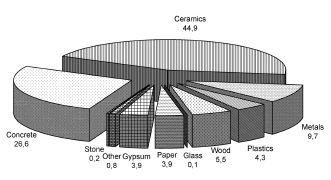
Figure 1. Mass composition of C&D debris
2.6 Calculation of recycled aggregate generated and comparison with current aggregate
The previous section shows that the percentage of stone materials, ceramic, concrete and mortar in the C&D waste is 71.7%. Therefore, from the 1.51 million tons of C&D debris generated in Galicia in 2007, 1.09 million metric tons of recycled aggregate could have been obtained.
The report prepared by ANEFA (the Spanish national association of aggregate producers) [7] stated that the amount of aggregate used for construction in 2006 in Galicia was 24.8 million metric tons. Therefore, the amount of recycled aggregate generated in Galicia in 2007 compared to the total amount of aggregate used in 2006 amounts to 4.4% of the total, which means that recycled aggregate does not represent any threat to the sector of natural aggregate. In addition, this analysis evidences that, in this particular market, recycled aggregate need not be used in complex applications.
3. TECHNICAL SPECIFICATIONS FOR C&D WASTE
Among the possible uses of aggregate in construction, railroad ballast and road pavements have their own cycles: the damaged materials that are removed are reused or recycled, therefore closing their own cycle. For other uses, technical specifications have been developed which depict the requirements and characteristics that must be fulfilled by these aggregates [8], [9], [10], [11].
3.1 C&D waste for structural Concrete
The current standard EHE-08[12] in its Annex 15 sets out recommendations for the use of concrete made with coarse recycled aggregate obtained from waste concrete crushing. This aggregate can be used in mass concrete or structural concrete up to strengths of 40 N/mm2. It is recommended that the dry content of recycled coarse aggregate does not exceed 20% of the total dry aggregate so as not to affect the final properties of concrete with respect to conventional concrete of similar strength. In Table 1 the requirements proposed by Article 28 and Annex 15 of the EHE-08 are included.
Table 1. Requirements for coarse aggregate for structural concrete (EHE-08)
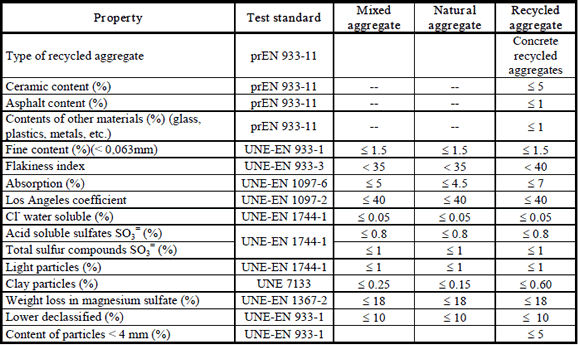
3.2 C&D waste for non-structural concrete
Annex 18 of EHE-08 [12] contains the specifications for the use of non-structural concrete and allows that 100% of recycled coarse aggregate may be used in the manufacture of non-structural concrete provided that it meets the specifications of Table 1.
3.3 Unbound granular material from C&D waste
The specifications listed in Table 2 are those given in the PG-3 [13] for traffic types T2, T3 and T4, which also include the requirements for recycled aggregate.
Table 2. Specifications for aggregate used for base course, sub-base course and sub-grade
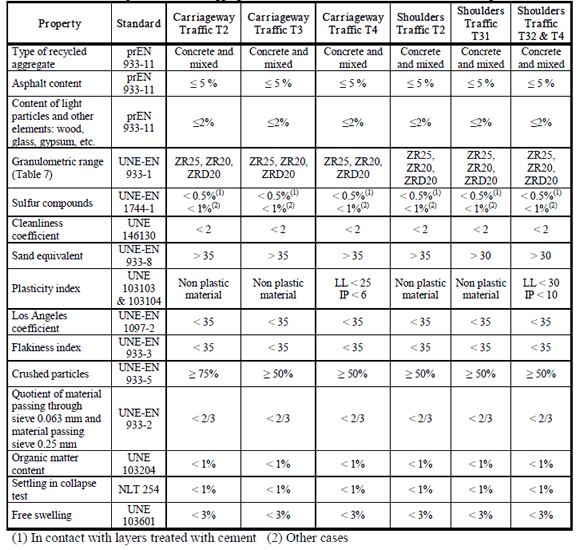
Generally, only recycled aggregate obtained from crushed concrete (containing over 90% of concrete and stone material) could meet all the specifications, so it is very unlikely to do so with mixed recycled aggregates (obtained from stone, concrete and ceramic). If recycled aggregate does not meet the specifications described in
Table 2, it can be mixed with natural aggregate in order to address these limitations. Typically, critical constraints are the Los Angeles coefficient (UNE-EN 1097-2) and the cleanliness coefficient (UNE146130). In order to calculate the percentage of substitution a linear correlation can be used.
3.4 Embankment construction with C&D waste
The Spanish standard PG-3 [13] states that appropriate or selected soil can be used for the coronation of embankments, and that selected, appropriate or tolerable soil may be used for both embankment foundation and core. Table 3 includes the above restrictions and the allowable use of recycled aggregate.
Table 3. Specifications for aggregates to embankments
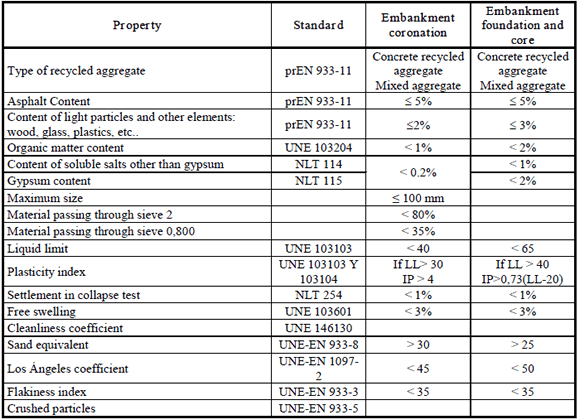
3.5 Soil-cement production with C&D waste
The specifications met by the aggregate to be used in the manufacture of soil-cement after standard PG-3 [13] are included in Table 4, and those specific to soil-cement are included in Table 5.
Table 4. Specifications for aggregates to manufacture soil-cement
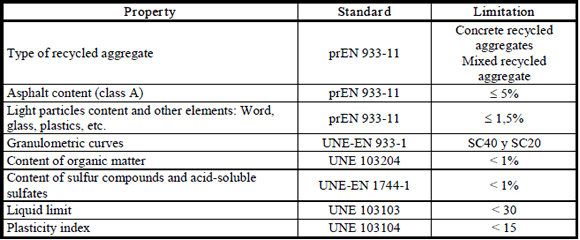
Table 5. Specifications of soil-cement

A retardant must be used to delay cement setting in order to increase the workability period of soil-cement.
3.6 Others uses
Use 1: Filling and leveling of industrial areas with C&D debris. Filling and leveling of industrial buildings. Filling and leveling of building works.
Use 2: Filling of trench works with C&D waste. Land filling and farm filling. Forest tracks and rural roads. (Use 2)
Use 3: Sports and leisure applications of C&D debris. Contribution of material to landfills. Environmental recovery of quarries (Use 3)
Use 4: Gardening with C&D debris.
For such uses, there is no regulation regarding the specifications that must be met by the aggregate. To fill this gap, the recommendations of Table 6 have been designed.
Table 6. Specifications for aggregate for others uses
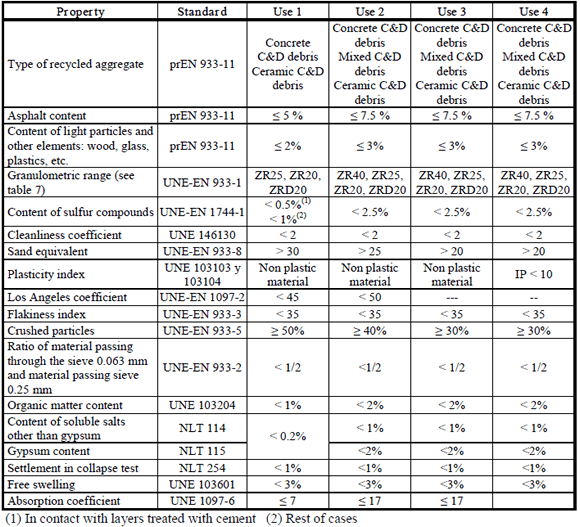
In general, concrete recycled aggregate (containing more than 90% stone and concrete materials) meets all the specifications, which is
not the case of both ceramic recycled aggregate (over 90% of ceramic material) and mixed recycled aggregate (a mixture of stony material, ceramic and concrete). If the recycled aggregate does not meet the specifications described in the table above it can be mixed with natural aggregate, so that the dry mixture meets the above limitations. Typically, critical constraints for mixed recycled aggregate are the Los Angeles coefficient (UNE-EN 1097-2) and the cleanliness coefficient (UNE 146130). A linear correlation can be assumed in both cases.
Table 7. Granulometric curves for recycled aggregate
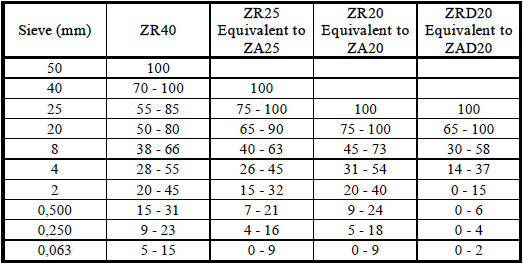
4. CONCLUSIONS
The conclusions resulting from this paper are:
- In the year 2007, 1,5 million tons of C&D waste has been generated in Galicia , which amount to 550 kilos per capita.
- The amount of C&D waste is very small compared to the annual consumption of aggregates.
- The previous conclusion leads to the fact that C&D waste in Spain does not have to be used in complex applications.
- Further studies should be conducted on the characteristics of recycled aggregates and their possible applications.
REFERENCES
[1] EUROPEAN WASTE CATALOGUE,. Commissión of European Communities. Directive 91/689/CEE. [ Links ]
[2] BRODERSEN, J., JUUL, J., JACOBSEN, H. Review of selected waste streams: Sewage sludge, construction and demolition waste, waste oils, waste from coal-fired power plants and biodegradable municipal waste. European Topic Centre on Waste, Project manager: Dimitros Tsotsos. European Environment Agency. 2002. [ Links ]
[3] COCHRAN, K., TOWNSEND, T., REINHART, D., HECK, H. Estimation of regional building-related C&D Debris generation and composition: Case study for Florida, U.S. Waste management 27 (2007): 921-931, 2007. [ Links ]
[4] FRANKLIN ASSOCIATES. Characterization of Building-Related Construction and Demolition Debris in the United States . U.S. Environmental Protection Agency. Report No. EPA530-R-98-010, 1998. [ Links ]
[5] INSTITUTO GALEGO DE ESTADÍSITICA. Datos estadísticos de población, edificación y vivienda en Galicia. Available: http://www.ige.eu. [Visited september, 2008] [ Links ]
[6] MAÑÀ I REIXACH, F, GONZÀLEZ I BARROSO, J., SAGRERA I CUSCÓ, A. Plan de Gestión de Residuos en las Obras de Construcción y Demolición; Programa Life. Dirección General de Medio Ambiente; Institut de Tecnología de la Construcció de Catalunya, Barcelona, 2000. [ Links ]
[7] ASOCIACIÓN DE EMPRESARIOS FABRICANTES DE ÁRIDOS (ANEFA). 2007. Estadísticas de áridos 2006. Available: http://www.geoscopio.com/escaparate/ docs2.pl?url=/empresas/anefa3//anefa/estadisticas/Estadisticas%202006-2007%20final.pdf& accion=abajo [visited march, 2009] . [ Links ]
[8] CRAWFORD, H.S. Market Development Study for Recycled Aggregate Products. Waste reduction Advisory Committee; Calgary, 2001. [ Links ]
[9] FUEYO, L. Manual de demoliciones, reciclaje y manipulación de materiales. Ed. Fueyo editores; Madrid, 2003. [ Links ]
[10] GRUPO DE TRABAJO ÁRIDOS RECICLADOS; AEN/CTN 146. Propuesta de Proyecto de Norma UNE Áridos Reciclados para su uso como Material de Construcción de Bases, Subbases y Explanadas, 1999. [ Links ]
[11] GRUPO DE TRABAJO HORMIGÓN RECICLADO. Comisión Permanente del Hormigón. Utilización del árido reciclado para la fabricación de hormigón estructural. Monografía de la Asociación Científico-Técnica del Hormigón Estructural (ACHE); Madrid, 2006. [ Links ]
[12] EHE-08. Instrucción de Hormigón Estructural. Publicaciones del Ministerio de Fomento; Secretaría General Técnica, Madrid, 2008. [ Links ]
[13] PG-3. Pliego de Prescripciones Técnicas Generales para Obras de Carreteras y Puentes. Obra preparada por Gerardo Bustos Pretes, Técnico Superior de la Administración General del Estado; Ediciones LITEAM; 4ª Edición actualizada a 6 de abril de 2004. [ Links ]














